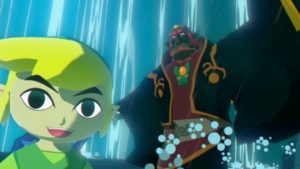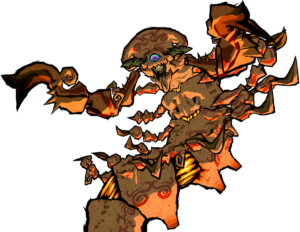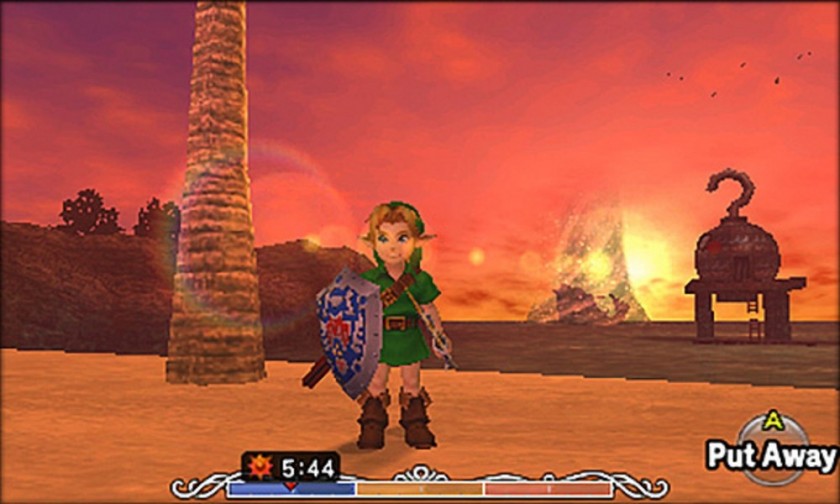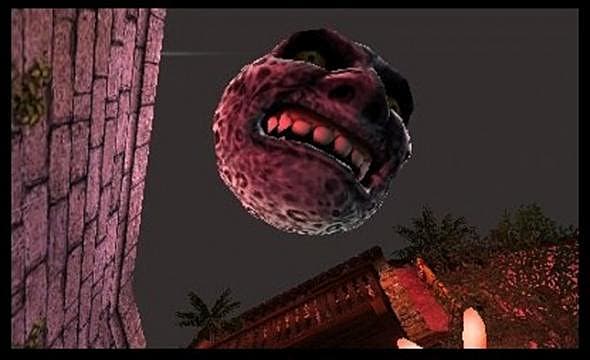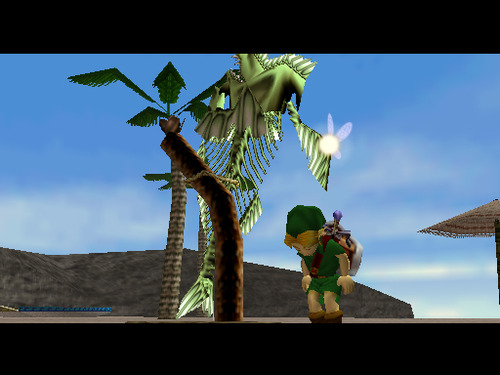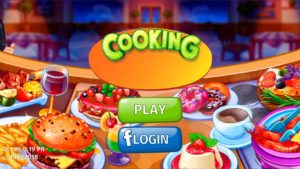
Cooking Craze is a free, downloadable game which name gives us a hint on its content and what and its “play” opportunities available for players. I am not a person who spends a lot of time playing digital games, so I took this situation as an advantage to really observe and experience the game. Through the following paragraphs, I will aim to describe my play experience and analyze the space of play to which I was transported when playing, the mechanics and rules of the game, and the way in which it creates meaning, among other factors.

Once first diving into the space of play, I was transported to a digital world with different cities. The game starts with the first city on the map, New York. Each city counts with 100 levels of difficulty, and after those are achieved, more cities are unlocked. At the bottom right corner of the home section, there is a world’s icon. When clicked, the game transports you to another setting where the next city icon -Paris- is displayed. There are options to go back to the home screen after exploring each of the game spaces.

The main space, however, is found on what we could call the “home screen”, in my case, it was the city of New York with different restaurants. The aspect of the game is not minimalistic, but rather the different spaces available in Cooking Craze are very detailed and elaborated. I would say the game has a colorful, bright, and vibrant aesthetic. It looks a lot like other “cooking” games available on the internet. Also, the background music is always the same and becomes annoying after a while -although you can turn it off in the settings section which is symbolized with a screw at the bottom right of the home screen. To some extent, the game’s aspect has excessive features and “information” which makes it difficult for the inexperienced player to understand how the game works, especially at the beginning of the play experience. However, the main objective of the game becomes clear easily as you interact with the home screen. The game consists of different cities with different restaurants and levels. Once you pass a particular amount of levels, you move to another restaurant, and each restaurant sells different products related to fast service. The main objective for the player is satisfying the customers’ desires by preparing the ordered food or drink items as fast as possible without making mistakes. Good performances are translated into receiving incentives or rewards such as coins, “spoons”, and comment cards once each level is achieved.
Fulfilling the main objective of the game allows the player to fulfill others. For instance, when earning coins and “spoons”, the player can “upgrade” the restaurant by buying new products or other features that make it easier for the player to perform actively. Once higher levels of difficulty are reached, upgrades are necessary to keep up with the game, as they help you cook more efficiently. The new features consist of new lives, extra-time for achieving each level’s specific goals (i.e., getting a specific number of coins and spoons), or “cupcakes” that help to keep the customers happy while the player is preparing their meals. Other objectives include fulfilling specific achievements (such as “Dream Kitchen”, completing all the upgrades in one restaurant), passing from restaurant to restaurant within different levels, and ultimately having worked in all of the cities’ restaurants (having started with lower levels of difficulty and finished with higher ones) and start over again in the next city.

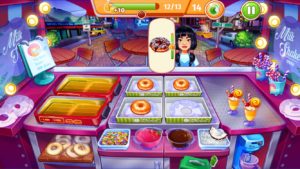
 .
. 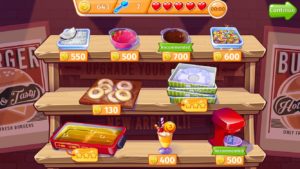
As each restaurant sells different products, the player has to learn how to prepare them once the experience at each restaurant begins. At the beginning of each experience, the player receives a short tutorial on the preparation of new products. However, the interaction the player has with the digital device where the game is being played is similar among the restaurants. As such, the first restaurant sells donuts and shakes, so to prepare them, the player has to pay attention to the customers who arrive, and their specific desires would appear on bubbles next to them. Then the player starts cooking. To cook a donut the player taps on the cooking plate, then on the sauce or topping, and later on the tray so that the customer receives the order. Similarly, to prepare a shake the player taps on the machine and when it’s ready, it taps again on the finished shake. All the products that are being “cooked” or prepared show a little analog clock next to them which determines the time that the product needs to get ready. Also, customers enter with a green bar that slowly decreases until reaching the color orange or red -this shows their waiting time. Angry customers can leave and also food can be overcooked -if this happens it will be wasted, and the player will lose time and points. Points are earned by satisfying the customers’ desires. In this way, we could say the objects or resources of the game are of course a digital device that allows you to download the game. Once “inside” the game space, the game’s objects are various and diverse, and are conformed by the cities, the city where you are playing, the restaurants, the chef who appears and gives you the instructions or congratulates you every time you pass a level, the different machines and materials available at each restaurant to prepare the final outcomes, the customers, the section for “upgrades”, and the rewards you get when achieving objectives.
As the first levels are relatively easy and slow, the player is in a way socialized into the mechanics or rules behind the scenes with the help of short tutorials. You learn how you required to tap on the pan for the product to appear on it and start cooking itself, instead of dragging the donut or hamburger to the pan. Then you have to tap on the same product so that it appears on the tray. The toppings work a bit different, as they require you to tap on them so they appear on the product that is on the tray instead of tapping on the product so the topping appears on it. The shakes are more straightforward, as you are only required to tap on the machine that prepares them. Once the products are ready, you have to tap on it. This feature forbids the player to choose the customer who will receive the finalized product. The system assumes that the one who has waited for the longest time is the one who deserves the product first, constraining the authority of the player to choose according to each situation.
The tapping mechanism restraints movement and also brings some “magic” to the game, as the player cannot move the products around the kitchen, but rather only tap on the available materials and machines so that they automatically appear or move -however this “movement” is not seen on the screen. Although the player is not responsible for these movements, it has to pay attention so that the cooking pan doesn’t burn the products. By giving the player this freedom, the game also creates a penalization that comes whenever a product is burnt. As such, the player has to pay attention not to “put” more products on the pans than trays are available at the moment. The player has no option to take out the cooked product from the pan to a place other than the trays. When a product is burnt, the screen shows text that indicates that “you should not let food get burnt and wasted”. However, the sender of the message is not specified. While playing, I assumed that it was the chef that “helped” me throughout the game, and that when those texts appeared, the chef (my boss) was scolding me. These moments were weird because after playing the game for several hours, I created a connection to it that made me feel negligent every time I wasted food. It was not clear how I needed to proceed with burnt food, as the pan and the product on it became black and the game did not allow me to continue cooking on that pan. I assumed I had to tap on it, however, as I did not see changes, I just waited for a couple of seconds until the pan was “magically” cleared. Also, it seems that the customers always have the exact value of the product, as the player does not have to give change. In fact, the player does not “see” and apparently neither receives visual money or coins.
Inside the play space of the restaurants, the player cannot move the trays, neither the cooking pans or other machines. Similarly, the player cannot move the toppings. Basically, the space of play has certain boundaries that keep the player from moving anything in the kitchens. The only thing the player can do is “tap” and pay attention to what is happening on the screen. The player (that at the moment is the restaurant’s employee) has to seek strategies that allow it to prepare the products required by the customers as fast as possible within the space’s boundaries. Whereas the player needs to play with “time”, the player has no authority over it. The player cannot open the restaurant and neither decide when to close it because the closing time indicates the end of the available time for play. In this sense, the space of play inside the restaurants is particularly rigid. On the home screen (conformed by the place of the city you are at), the space certainly changes. Although the player cannot play the next level without completing the current one, players have the freedom to navigate through all the accomplished levels at any moment and in any order. To do so, the player has to tap on the levels’ numbers. Also, the player has the option of navigating through the whole city by moving a finger or fingers in different directions.
Overall, the play gives the player some freedom for movement, but also provides various constraints. As a player, I was excited by the possibility of navigating through the city and having the opportunity to “travel” to other ones while cooking in different restaurants. The possibility of cooking a variety of products also thrilled me, but I would have wanted to have more freedom in choosing the products that I needed to prepare. Another remarkable point is that the game gives the option to buy “spoons” with real money. Having more spoons can help the player with upgrades and in overall improving its chances for achieving the game’s objectives. In this way, not being able to buy with real money could be seen as a “boundary” between the digital and physical context of the game, as if you cannot buy spoons, you have fewer chances to “win” each level.
Four buttons are always present in the bottom right corner of the home screen: a “cart” for either buying boosts with spoons or spoons with real money, “achievements” for following the completed and uncompleted achievements, the “world map” which was previously described, and “settings”. On settings, the player can decide on activating the sound or music of the game and whether to connect with “friends” via Facebook or not. I did not utilize this option for personal reasons.
The digital context of the game consists of the game’s “world”: the different cities and restaurants among the cities -specifically their kitchens and front desks. However, the game can be played anywhere and at any time if it is downloaded to a phone and the phone is charged. The game is both creative and destructive, as it gives you the opportunity to create a limited amount of pre-designed products and design restaurants by upgrading them. However, the player can decide to leave products burnt, make the customers feel unsatisfied and angry, and to make the restaurant fail by not updating the machines. This could happen if the player decides to keep the coins for himself instead of spending them to make the restaurant better, as the player may realize -as I did- that the restaurant doesn’t belong to him or her. In a way, you are investing in your boss’s or someone’s restaurant. The game is in a way appropriative because it does not allow the player to do other things on the phone while playing. The game is also disruptive because when deciding to play, the player stops anything else he or she was doing with the phone. The game can also disrupt the real-life context, as the player can get too immersed in the game. Considering the large number of levels, cities and therefore possibilities of play, the player can spend hours and hours sitting with the phone without paying attention to daily life. As the game is divided between levels, the player has a sense of “winning” after achieving the objectives of each one of them. However, I cannot size the time needed to “win” the whole game by winning all the levels from all cities. In fact, I do not know if that is even possible.
The game creates meaning by transforming the objects on the screen in a city with restaurants. The objects by themselves may lack sense, yet together they create an opportunity for play. The music, colors and physical design of the game immerse the player into a new “world” where the player can work at different restaurants. The variation between restaurants, levels, products (as well as their upgrades), and the constant rewards, have the intention to ignite in the player a sense of authority and freedom. As the player plays, it becomes better, and as it becomes better, it generates different and better opportunities for play. If we connect the game to real life, by playing, players can practice following instructions efficiently, as well as feel the pressure of working with the time constraints that also exist “outside” the game. In a way, the player can develop a sense of empathy for restaurants’ employees, by experiencing the difficulties they face in their daily lives.

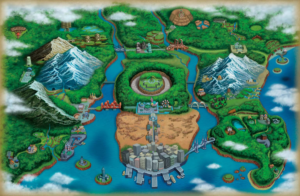









 .
. 


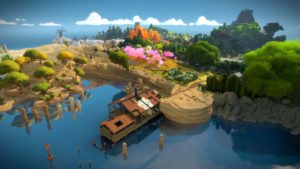


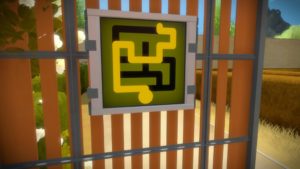

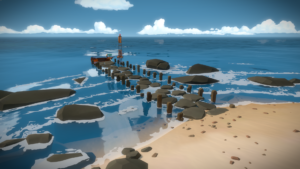




 .
. 


